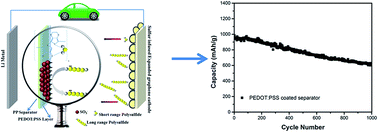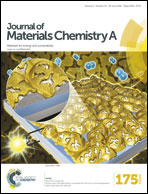Bifunctional separator as a polysulfide mediator for highly stable Li–S batteries†
Abstract
The shuttling process involving lithium polysulfides is one of the major factors responsible for the degradation in capacity of lithium–sulfur batteries (LSBs). Herein, we demonstrate a novel and simple strategy—using a bifunctional separator, prepared by spraying poly(3,4-ethylenedioxythiophene):poly(styrene sulfonate) (PEDOT:PSS) on a pristine separator—to obtain long-cycle LSBs. The negatively charged SO3− groups present in PSS act as an electrostatic shield for soluble lithium polysulfides through mutual coulombic repulsion, whereas PEDOT provides chemical interactions with insoluble polysulfides (Li2S, Li2S2). The dual shielding effect can provide an efficient protection from the shuttling phenomenon by confining lithium polysulfides to the cathode side of the battery. Moreover, coating with PEDOT:PSS transforms the surface of the separator from hydrophobic to hydrophilic, thereby improving the electrochemical performance. We observed an ultralow decay of 0.0364% per cycle when we ran the battery for 1000 cycles at 0.25C—far superior to that of the pristine separator and one of the lowest recorded values reported at a low current density. We examined the versatility of our separator by preparing a flexible battery that functioned well under various stress conditions; it displayed flawless performance. Accordingly, this economical and simple strategy appears to be an ideal platform for commercialization of LSBs.


 Please wait while we load your content...
Please wait while we load your content...